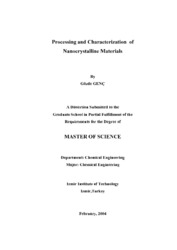Please use this identifier to cite or link to this item:
https://hdl.handle.net/11147/3736| Title: | Processing and Characterization of Nanocrystalline Materials | Authors: | Genç, Gözde | Advisors: | Çiftçioğlu, Muhsin | Publisher: | Izmir Institute of Technology | Abstract: | Nanocrystalline materials with grain sizes under 100 nm have been counted as a very promising class of ceramic materials. The decrease in grain size imparts superior structural properties to the ceramic materials like increased fracture toughness, wear resistance and superplastic deformation at high temperatures. So, nanocrystalline ceramics can be used as structural materials in a wide range of uses covering advanced engineering applications such as aircraft and automotive technologies as well as electronics, computation and material sciences. Nanocrystalline alumina has been a popular research subject for the last decade because of the superior structural properties of alumina besides lower cost compared to other nanocrystalline materials like zirconia and titania. The raw materials are generally transitional aluminas or aluminum hydroxides such as boehmite and gibbsite all of which are widely used in industry.The main problem in nanocrystalline alumina production is to cope with agglomeration of fine powders or nano-particles in solutions due to interaction forces. Agglomeration cause nonhomogeneous microstructure with respectively larger pores which are very hard to eliminate during sintering. In this study a nanocrystalline commercial boehmite powder is used as the starting material and a homogeneous microstructure with respectively high density is aimed. Ultrasonic treatment is applied in order to reduce particle size and the stable dispersions of boehmite powder with a solid content of 30wt% was dried by spray drying. The effect of ultrasonic treatment, spray drying and compaction conditions were investigated and compared with bodies compacted from untreated powders. To see the effect of seeding on phase transformation behavior of boehmite, alpha alumina particles produced by combustion synthesis and broken into crystallites by ultrasonic treatment were used with a seed content less than 0.5%. Even that low amount of a-alumina reduced the transformation temperature by 100C but did not improve densification of alumina compacts. The homogeneity of microstructure obtained by ultrasonic treatment and granulation by spray drying yielded the highest relative densities of 65.5 % of the theoretical density. The treatment has also led more uniform microstructures compared to untreated and seeded samples during the a-phase transition which is the most important stage for densification. | Description: | Thesis (Master)--Izmir Institute of Technology, Chemical Engineering, Izmir, 2004 Includes bibliographical references (leaves: 89-95) Text in English; Abstract: Turkish and English xiii, 95 leaves |
URI: | http://hdl.handle.net/11147/3736 |
| Appears in Collections: | Master Degree / Yüksek Lisans Tezleri |
Files in This Item:
| File | Description | Size | Format | |
|---|---|---|---|---|
| T000294.pdf | MasterThesis | 8.1 MB | Adobe PDF |  View/Open |
CORE Recommender
Page view(s)
238
checked on May 5, 2025
Download(s)
164
checked on May 5, 2025
Google ScholarTM
Check
Items in GCRIS Repository are protected by copyright, with all rights reserved, unless otherwise indicated.